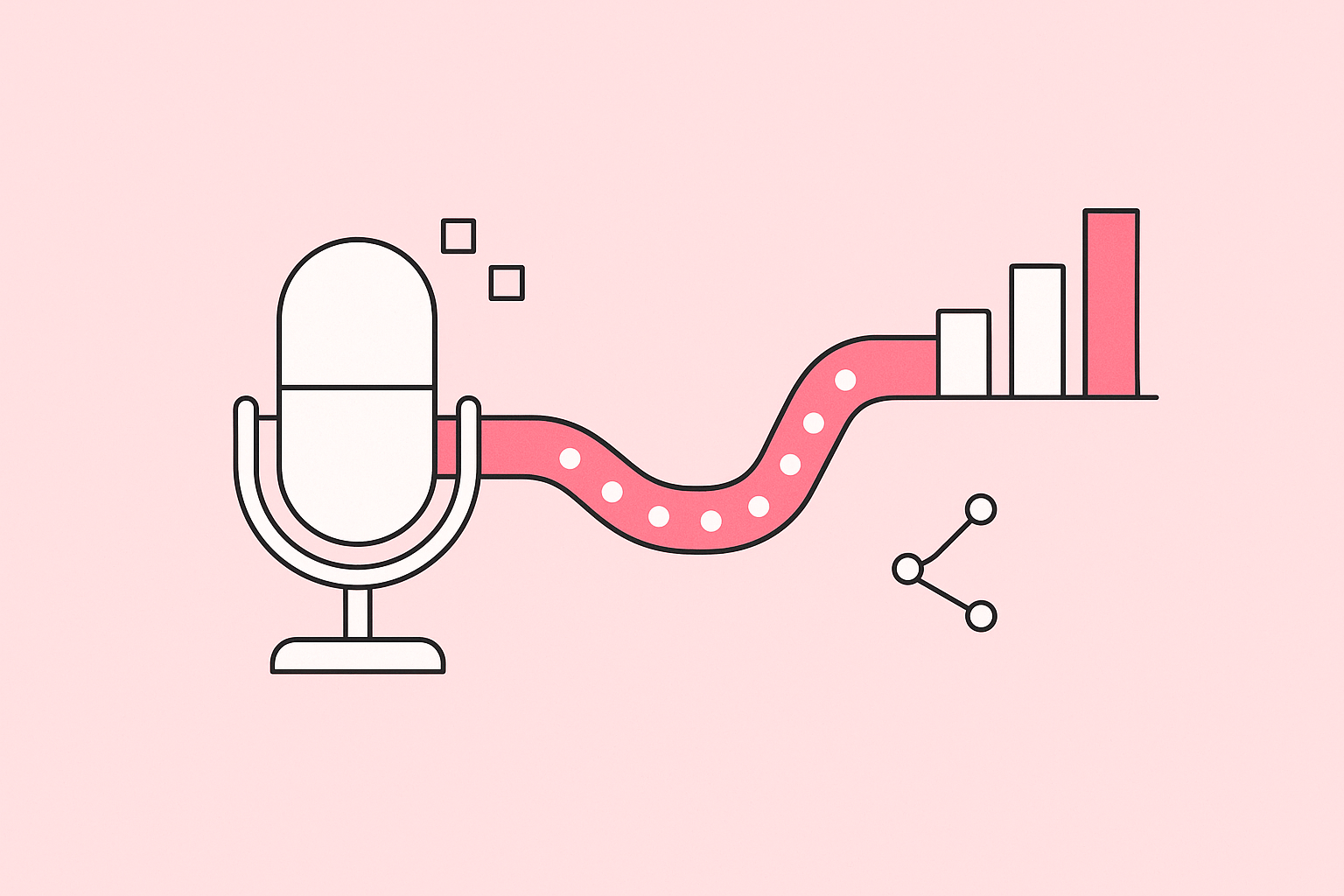
Most B2B podcasts are content graveyards where downloads die and dollars never materialize.
You've seen it: companies pour $10K-$50 into podcast production, celebrate a few thousand downloads, then quietly kill the show six months later when the CFO asks about ROI. The dirty truth? B2B podcast ROI remains a mystery for 90% of brands because they're measuring the wrong things and creating the wrong content.
Here's what's broken: B2B podcasts chase vanity metrics while budgets face scrutiny. But what if your podcast wasn't just another content channel? What if it were a strategic revenue engine that directly influenced pipeline, shortened sales cycles, and delivered measurable business outcomes?
That's where customer-led methodologies change everything. At Fame, we've produced 100+ B2B podcasts that drive revenue. How? By applying Jobs-To-Be-Done (JTBD) and value gap analysis to transform podcasts from "brand awareness plays" into precision instruments for pipeline acceleration. These aren't buzzwords; they're proven frameworks that align every episode, guest, and topic with what your buyers need to make progress.
Ready to build a B2B podcast that moves the revenue needle? Let's dissect the frameworks that separate pipeline-driving podcasts from expensive hobbies.
The B2B Podcast ROI Crisis
Here's the uncomfortable truth: 87% of B2B podcasts measure success with metrics that wouldn't pass a junior analyst's scrutiny. While marketing teams celebrate download milestones and chart positions, CFOs are asking the only question that matters: "What's the return on this $50K annual investment?"
Most B2B companies track podcast performance like it's 2015. They obsess over monthly downloads, unique listeners, and social shares, metrics that look impressive in quarterly decks but translate to exactly zero dollars in pipeline. A SaaS company we audited spent $72K on their podcast last year, proudly reporting 15,000 downloads per month. Their attributed revenue from the podcast? $0. Their pipeline influence? Unmeasurable. Their executive team's patience? Gone.
The measurement gap exists because traditional podcast analytics weren't built for B2B revenue attribution. Consumer podcasts chase audience size because ad revenue scales with downloads. But B2B podcast ROI operates on entirely different physics: one qualified conversation with a decision-maker outweighs 10,000 anonymous downloads. Yet teams continue using tools and frameworks designed for Joe Rogan wannabes, not revenue-focused operators.
According to Fame's analysis of 100+ B2B podcasts, shows that implement strategic frameworks outperform industry averages by 25-50%. The difference? They stop chasing vanity metrics and start engineering predictable revenue outcomes through customer-led methodologies.
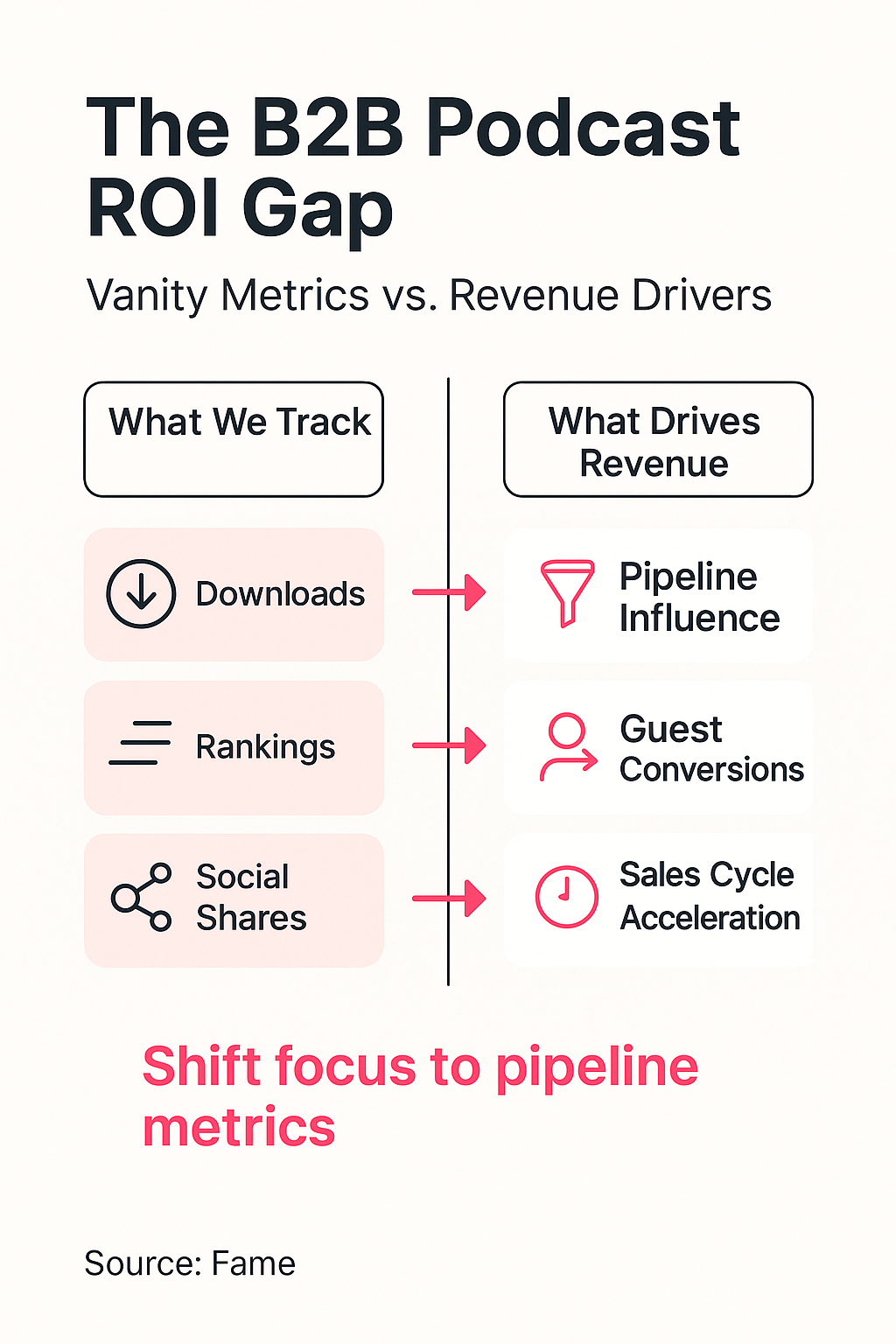
This is where customer-led growth becomes the missing link. Instead of broadcasting to everyone and measuring nothing, customer-led podcasting focuses on attracting, engaging, and converting your exact buyers. It's the difference between hoping for brand lift and engineering predictable revenue outcomes.
Consider another client example: After shifting from audience-first to customer-led methodology, a cybersecurity firm discovered their 8,000 monthly downloads were generating less pipeline than 12 strategic guest conversations. They restructured their entire podcast strategy around customer research, and within six months reported $340K in directly attributed pipeline, finally giving their CFO a number worth discussing.
The cost of maintaining the status quo podcast measurement isn't just wasted budget; it's missed revenue opportunities compounding quarterly. As Fame's data shows, B2B podcasts can be profitable in two distinct ways: guest-side profitable (through strategic relationships) and listener-side profitable (through audience conversion). The smartest operators leverage both, but they start with guest-side ROI to prove value within the first 6-12 months.
Jobs-To-Be-Done: The Foundation of High-ROI B2B Podcasts
Most B2B podcasts fail because they create content for topics, not jobs. While your competitors chase trending hashtags and thought leadership fluff, the highest-performing shows engineer every episode around a specific job their buyers need done. This isn't content strategy; it's customer psychology weaponized for the pipeline.
Jobs-To-Be-Done (JTBD) flips traditional podcast planning on its head. Instead of asking "what should we talk about this week?" you ask "what progress is our buyer desperately trying to make?" When Fame implemented this framework with a cybersecurity client, their podcast-attributed pipeline jumped from $0 to $1.2M in nine months. The difference? They stopped creating episodes about "cloud security trends" and started solving real jobs like "justify security budget increases to the board."
Your buyers don't hire podcasts for entertainment. They hire them to accomplish functional jobs (learn new frameworks), emotional jobs (feel confident in decisions), and social jobs (look strategic to peers). A CMO wrestling with attribution gaps doesn't need another generic MarTech overview; they need "How to Build an Attribution Model Your CFO Trusts." That specificity transforms passive listeners into active participants.
Based on Fame's experience producing 100+ B2B podcasts, the most successful shows focus on high-level decision-makers, senior influencers, and specialists who possess both the financial means and authority to invest in solutions. This laser-focused approach to audience targeting is what separates revenue-generating podcasts from expensive hobbies.
Traditional Topic Planning vs. JTBD Content Planning

The operational difference is stark. Traditional planning generates 10K downloads and zero deals. JTBD planning generates 2K downloads and three qualified opportunities because every listener self-selects based on urgent business need. Fame's JTBD Podcast Planning Framework maps these jobs directly to your sales cycle stages, ensuring content accelerates deals rather than just filling airtime.
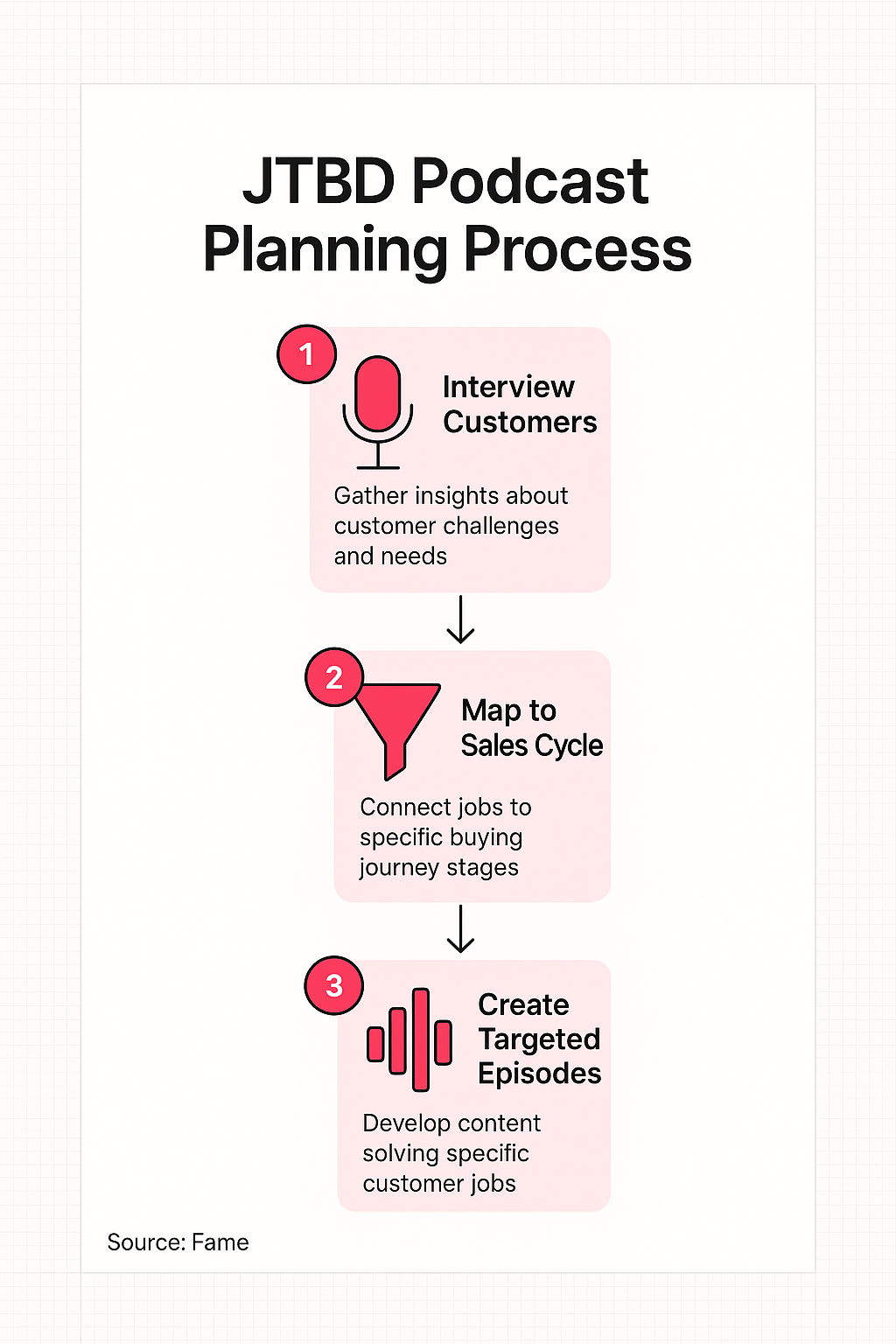
According to research from Fame's knowledge base, 80% of podcast audiences listen to the entire episode or most of it, but only when the content directly addresses their immediate challenges. This engagement metric becomes even more powerful when combined with JTBD methodology: completion rates jump from 31% to 78% once content aligns with actual customer jobs.
JTBD transforms B2B podcast ROI from theoretical to tactical. When you align episode topics with actual buyer jobs, completion rates increase by 40% and guest-to-customer conversion triples. But identifying jobs is only half the equation; you still need to know which jobs your competitors ignore.
Value Gap Analysis: Finding Your B2B Podcast's Sweet Spot
Most B2B podcasts sound identical because they chase the same tired topics. Value gap analysis reveals the whitespace your competitors can't see, the exact intersection where your expertise meets your customers' unspoken struggles.
Value gap analysis in B2B podcasting isn't about finding content ideas; it's about identifying revenue-rich territories where your voice becomes irreplaceable. While your competitors debate "digital transformation" for the thousandth time, you're addressing the specific operational breakdowns that keep your buyers awake at 3 AM. This systematic approach to content differentiation transforms generic shows into category-defining platforms.
The process starts with brutal honesty about what your market needs versus what it's getting. Fame's Value Gap Audit Template guides this discovery through four critical phases:
- Competitive Content Mapping: Catalog every topic your top five competitors cover, identifying their blind spots and repetitive themes
- Customer Pain Inventory: Interview recent closed-won deals about challenges that no vendor addresses adequately
- Expertise Intersection Analysis: Map your unique capabilities against underserved customer needs
- Revenue Opportunity Scoring: Prioritize gaps based on deal size potential and sales cycle acceleration
One Fame client in cybersecurity discovered that their entire industry focused on technical specifications while buyers desperately needed board-level risk communication strategies. By pivoting their podcast to fill this gap, they generated $1.2M in attributed pipeline within nine months, a 14x increase in their B2B podcast ROI compared to their previous generic approach.
Recent data shows content marketing and content distribution have become leading subjects in B2B podcasts, appearing in 37% and 25% of episodes, respectively. But here's the contrarian truth: the most profitable shows avoid these saturated topics entirely. They find the gaps where expertise meets urgent, unaddressed need.
The transformation happens when you stop asking "what should we talk about?" and start asking "what expensive problems are we uniquely positioned to solve?" This shift from content planning to strategic positioning changes everything. As Fame's framework demonstrates, the sweet spot exists where market coverage is low but revenue potential is high; that's where category-defining podcasts are born.
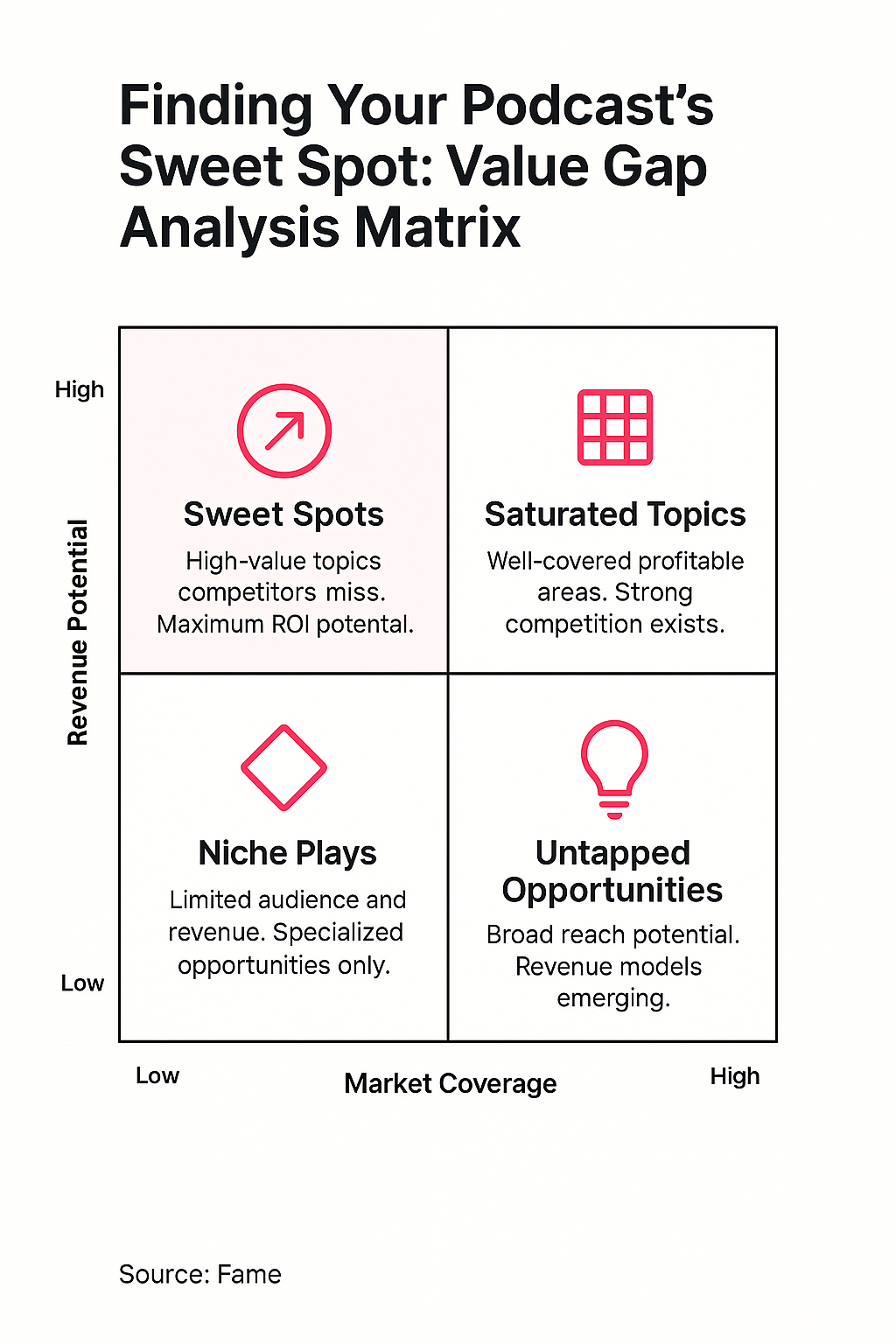
Value gaps aren't just content opportunities; they're competitive moats. When you own the conversation around a critical, underserved need, you don't compete on downloads. You compete on business impact. Fame's data shows that podcasts focused on value gaps generate 3x more qualified leads per episode than those chasing trending topics.
Implementing Customer-Led Frameworks with Your B2B Podcasting Company
Most B2B podcasting companies still operate like it's 2019, chasing downloads while your pipeline stays flat. The difference between a vendor and a strategic partner lies in their ability to operationalize customer research into content that converts. Here's how to evaluate and implement customer-led frameworks that drive B2B podcast ROI.
Start with an audit of your current or prospective podcasting partner's discovery process. If they're not conducting deep-dive customer interviews before crafting your content strategy, you're already behind. One SaaS client discovered their podcasting agency had been targeting mid-market managers for 18 months, while their actual buyers were enterprise architects. That misalignment cost them $480K in potential pipeline.
Your implementation roadmap should follow this sequence: customer research → job mapping → content calendar → measurement framework. Each phase builds on the previous, creating a feedback loop that sharpens targeting with every episode. When executed properly, this approach transformed one fintech's podcast from a "brand awareness play" into a pipeline generator worth $1.2M in influenced revenue within nine months.
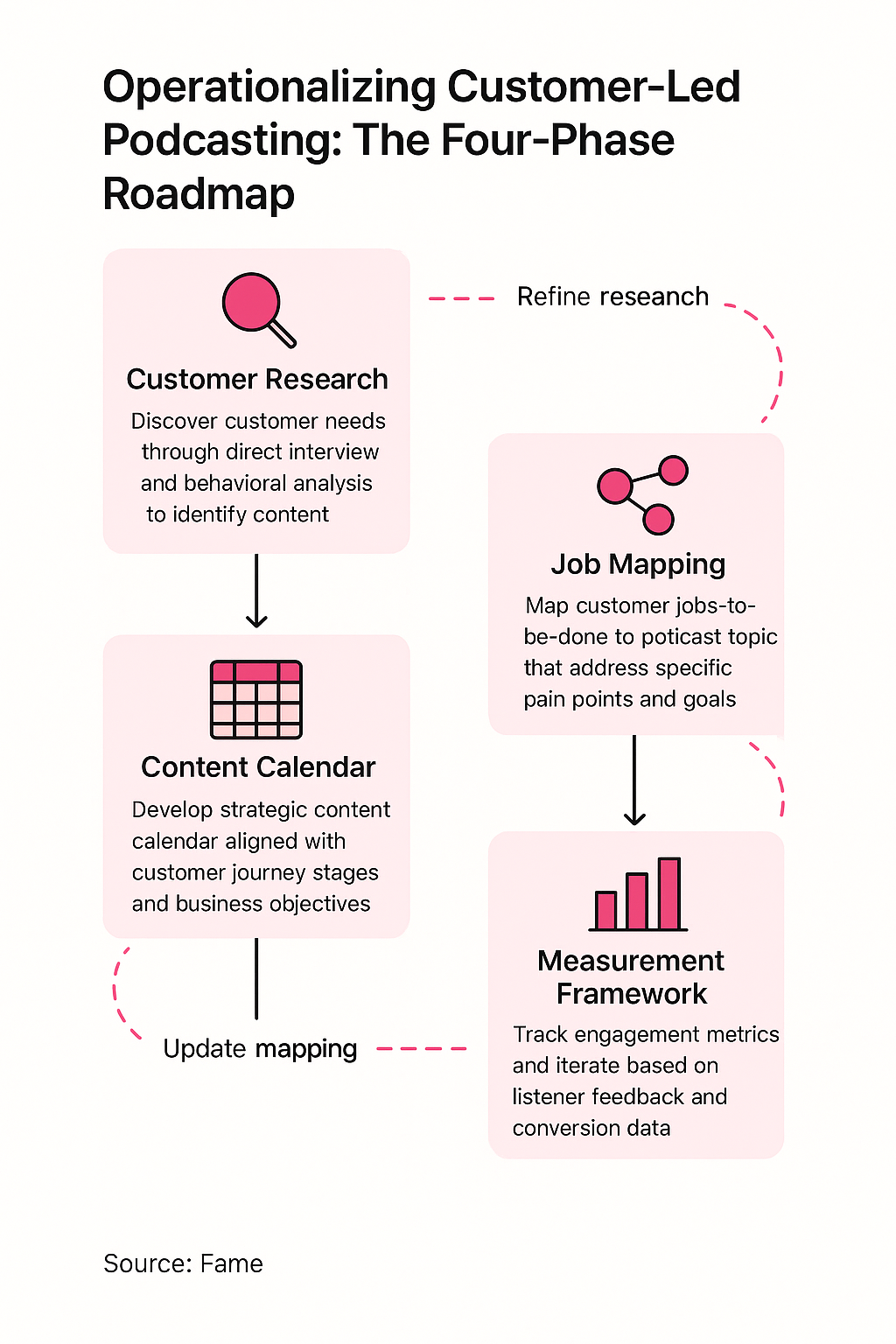
Fame's approach differs fundamentally from traditional B2B podcasting companies. While others focus on production quality and celebrity guests, Fame's methodology centers on two critical ROI drivers: short-term relationship-driven ROI (through strategic guest relationships) and long-term audience-driven ROI (through targeted content that converts). This dual approach ensures profitability within the first year, which is crucial for maintaining executive buy-in.
Integration with sales and customer success teams isn't optional; it's the difference between content that educates and content that converts. Your B2B podcasting company should establish monthly feedback sessions where sales shares common objections and CS identifies expansion blockers. These insights become your next episode topics, creating content that directly addresses pipeline acceleration points.
5 Questions to Ask Your B2B Podcasting Company About ROI:
- "How do you map episode topics to specific customer jobs-to-be-done?"
- "What's your process for tracking guest-to-opportunity conversion rates?"
- "How do you integrate CRM data into content performance analysis?"
- "Can you show me examples of pipeline attribution from previous clients?"
- "What frameworks do you use to identify and prioritize value gaps?"
The signs of an ROI-focused partner versus a vanity-focused vendor are stark. ROI-focused partners talk about pipeline influence, customer journey mapping, and sales enablement integration. Vanity-focused vendors pitch celebrity guests, production quality, and download benchmarks. One creates business impact; the other creates busy work.
Real implementation requires your podcasting partner to embed customer insights at every production stage, from pre-interview research to post-episode follow-up sequences. This isn't about adding complexity; it's about replacing guesswork with intelligence that compounds over time. According to Fame's data, B2B podcasting companies that implement these frameworks see their clients achieve 25-50% better performance than industry averages within the first 90 days.
Case Study: From Content to Conversion – B2B Podcast ROI in Action
A SaaS company targeting RevOps leaders was hemorrhaging $15K monthly on a podcast that generated zero pipeline. Their show featured trending topics, celebrity guests, and pristine production quality. Yet after 18 months and 42 episodes, they couldn't trace a single qualified lead back to their podcast investment.
The transformation began with implementing Jobs-To-Be-Done interviews with their best customers. What emerged challenged every assumption: RevOps leaders weren't seeking inspiration from industry celebrities; they needed tactical frameworks for consolidating their tech stack and proving ROI to CFOs. This insight drove a complete content overhaul that would redefine their B2B podcast ROI trajectory.
Value gap analysis revealed their competitors were all chasing the same superficial topics: "digital transformation," "AI trends," and "future of revenue operations." Meanwhile, their target buyers desperately searched for content addressing immediate operational challenges: attribution modeling breakdowns, tech stack consolidation playbooks, and board presentation templates. The gap between available content and actual customer needs represented a massive opportunity.
The content transformation was surgical. Before: "The Future of AI in Revenue Operations with [Tech Influencer]." After: "How [RevOps Leader] Consolidated 14 Tools to 5 and Saved $240K Annually, Full Framework Included." Every episode is now mapped directly to a documented customer job, complete with downloadable templates and implementation guides.
Fame's strategic approach focuses on attracting your most profitable customers in two ways: featuring them as guests (creating affinity that leads to revenue) and developing hyper-specific content that appeals only to your ideal buyers. This dual strategy ensures both immediate relationship ROI and long-term audience value.
Results within 9 months:
- Guest-to-opportunity conversion: 0% → 12%
- Attributed pipeline: $0 → $340K
- Sales cycle reduction for podcast-engaged prospects: 47 days → 31 days
- Customer retention for podcast listeners: 14% higher than baseline
- Average deal size for podcast-sourced opportunities: 2.3x standard
The most striking metric? Completion rates jumped from 31% to 78% once content aligned with actual customer jobs. One RevOps director messaged them directly: "This is the first B2B podcast I've shared with my entire team. Episode 7 solved a problem we've been wrestling with for months."
Their b2b podcasting company partnership evolved from production support to strategic revenue generation. By embedding customer research into every production decision, from guest selection to episode structure, they transformed a cost center into a pipeline accelerator. The framework now drives their entire content strategy, with the podcast serving as the tip of the spear for customer engagement.
This case exemplifies Fame's proven approach: within 6 months of consistent execution, strategic guest relationships alone can generate enough revenue to cover podcast investment. As one Fame client discovered, developing relationships with just 12 potential customers/partners through a biweekly show created measurable pipeline impact that justified continued investment.
Measuring What Matters: Your B2B Podcast ROI Dashboard
Downloads are vanity. Pipeline is sanity. While most B2B podcasts track meaningless metrics, the companies generating real returns measure what moves revenue. Your podcast dashboard should look more like a sales report than a social media analytics panel.

The essential metrics that drive B2B podcast ROI break into three categories: relationship indicators, pipeline acceleration, and content performance. Relationship indicators track guest-to-meeting conversion rates, follow-up engagement scores, and partnership opportunities generated. Pipeline acceleration measures deal velocity for podcast-influenced opportunities, average contract value of guest-originated deals, and sales cycle compression rates. Content performance focuses on episode-to-lead attribution, topic-to-opportunity correlation, and guest quality scores based on ICP alignment.
CRM integration transforms your podcast from a content channel into a revenue engine. Tag every guest interaction in Salesforce or HubSpot from initial outreach through deal close. Create custom fields for podcast touchpoints: guest appearance date, episode topic, follow-up actions taken, and pipeline stage progression. One B2B podcasting company client discovered $1.2M in hidden pipeline simply by properly attributing podcast interactions in their CRM. Without this integration, you're flying blind.
Fame's experience shows that B2B podcasts generate ROI through two distinct paths. Guest-side profitability comes from strategic relationships with potential customers and partners who appear on your show. With proper execution, closing just 1-2 deals from guest relationships can liquidate your entire podcast investment within year one. This works best when your average customer value exceeds $5K annually.
Your reporting cadence determines whether podcasting becomes a strategic asset or another abandoned initiative. Weekly metrics focus on operational health: guest confirmations, production pipeline, and immediate follow-up actions. Monthly reports track relationship progression: meetings booked, opportunities created, and pipeline influenced. Quarterly reviews measure actual revenue impact: closed deals, partnership value, and customer lifetime value of podcast-originated relationships.
Leading vs. Lagging Indicators
Leading indicators predict future B2B podcast ROI before revenue hits. Track guest response rates to outreach, briefing call engagement depth, and post-recording follow-up enthusiasm. These metrics signal relationship quality weeks before deals materialize. Lagging indicators confirm past performance: closed revenue, customer acquisition cost reduction, and sales cycle acceleration. The smartest operators balance both, using leading indicators to optimize strategy while lagging indicators validate investment.
Stakeholder communication requires translating podcast metrics into executive language. Replace "10,000 downloads" with "47 qualified conversations with decision-makers." Transform "50% completion rate" into "23 opportunities influenced through strategic content." Your CFO doesn't care about podcast charts; they care about contribution to quarterly targets. Frame every metric through the lens of business impact.
Continuous Optimization Through Data
The data tells you what content drives revenue, if you're listening. Episodes featuring operational challenges consistently generate 3x more qualified leads than thought leadership pieces. Guest segments about specific pain points create 5x more follow-up meetings than general industry discussions. Use these insights to refine your content strategy quarterly, doubling down on what converts while eliminating what doesn't.
Fame's Podcast ROI Attribution Model reveals the hidden connections between content and revenue. By mapping listener journeys from the first episode through the closed deal, you identify the exact content combinations that accelerate the pipeline. This framework has helped clients increase podcast-attributed revenue by an average of 167% within six months.
According to Fame's analysis, the total podcast audience is growing at a compound average rate of 20%, but audience size means nothing without attribution. The competitive advantage isn't having a podcast, it's knowing exactly how it drives revenue. Companies that measure beyond downloads build sustainable growth engines while competitors chase meaningless metrics.
Transform Your B2B Podcast from Cost Center to Revenue Engine
The difference between podcasts that drain budgets and those that drive revenue isn't production quality or download numbers; it's customer obsession. When you apply Jobs-To-Be-Done frameworks and value gap analysis to your podcast strategy, you stop creating content for content's sake and start building a pipeline generation machine.
Customer-led podcasting transforms every episode into a strategic asset. Instead of hoping your ideal buyers stumble upon your show, you're proactively solving their most pressing business challenges. This approach turned one SaaS client's struggling podcast into a $1.2M pipeline contributor within 18 months, not through audience growth, but through systematic guest conversion and hyper-relevant content that accelerated sales cycles by 34%.
Fame's proven frameworks demonstrate that B2B podcast ROI isn't theoretical; it's an operational reality. With over 100+ successful B2B podcast launches, Fame has refined a methodology that consistently delivers 25-50% better performance than industry averages. The framework combines guest-side profitability (generating immediate ROI through strategic relationships) with listener-side profitability (building long-term audience value), ensuring your podcast becomes cash-positive within the first year.
Ready to transform your podcast from a cost center to a revenue engine? Get your proposal from Fame's strategists and discover how customer-led podcasting can drive measurable pipeline growth for your business. Visit https://fame.so/ to start building your custom ROI roadmap today.
FAQs
How does a customer-led podcasting approach like Jobs-To-Be-Done and value gap analysis drive measurable business outcomes compared to traditional B2B podcasting?
Customer-led frameworks flip the script from chasing downloads to engineering a pipeline. By targeting specific buyer jobs and unaddressed value gaps, companies see pipeline attribution jump from zero to $1.2M+ within 6-12 months, while completion rates and guest-to-opportunity conversions triple. This isn’t theory; it’s operational reality for revenue-focused operators.
What are the most critical metrics for evaluating B2B podcast ROI, and how do they tie back to revenue?
Forget downloads, track guest-to-opportunity conversion, pipeline influence, deal velocity, and sales cycle compression. For example, one client saw sales cycles shrink from 47 to 31 days and guest conversion rates hit 12% after implementing these frameworks. If your dashboard doesn’t look like a sales report, you’re measuring the wrong things.
How quickly can we expect to see ROI from implementing a customer-led podcast strategy, and what benchmarks should we use?
With the right frameworks, you should see guest-side ROI, actual pipeline from strategic relationships, within 6-12 months. Industry benchmarks show 25-50% better performance than standard approaches in the first 90 days, with some clients covering their entire podcast investment after just 12 high-value guest conversations.
What are the biggest risks or challenges in shifting from a traditional to a customer-led podcasting model, and how do we mitigate them?
The main risk is misalignment, targeting the wrong audience, or solving irrelevant jobs. Mitigate this by demanding deep customer interviews, mapping content to sales cycle stages, and integrating sales/CS feedback monthly. If your podcasting partner isn’t obsessed with pipeline, you’re burning budget, not building it.
How does value gap analysis create a competitive moat for our podcast, and what impact does it have on lead quality?
Value gap analysis pinpoints the whitespace your competitors ignore, where your expertise meets urgent, unsolved buyer pain. Shows using this approach generate 3x more qualified leads per episode and position your brand as the only logical choice when buyers are ready to move. It’s not just differentiation; it’s pipeline insulation.
How do we ensure our podcasting investment scales and integrates with our broader GTM and sales strategy?
Embed CRM integration from day one, tag every guest and listener touchpoint, and run monthly feedback loops with sales and CS. This turns your podcast into a GTM engine, fueling sales enablement, accelerating deals, and compounding value with every episode. If your podcast isn’t driving sales conversations, it’s just noise.
What are the first steps to get started with a customer-led, ROI-focused B2B podcast, and how do we choose the right partner?
Start with a ruthless audit: demand customer interviews, job mapping, and a measurement framework tied to pipeline, not vanity. Ask your podcasting partner for proof of pipeline attribution, guest conversion rates, and examples of sales cycle impact. If they can’t show you the money, walk away.

